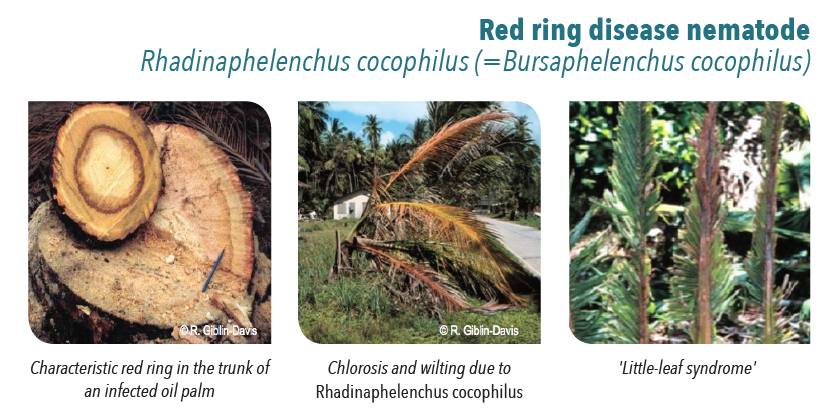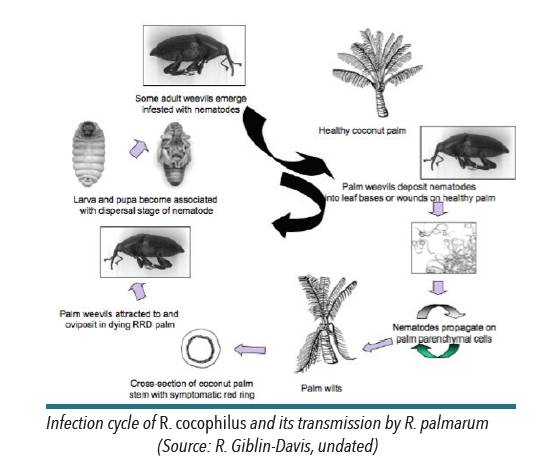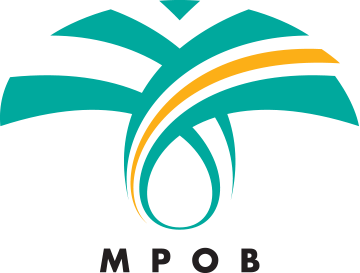General Information
General Information Rhadinaphelenchus cocophilus is a serious pest of palms, causing up to 10%-15% annual losses. Heaviest losses occur at the end of the wet season and in the first 2 or 3 months of the dry season. Infected palms usually die with in a few months. There is no known treatment for this disease.

R. cocophilus is a parasitic nematode of plants. It is vectored by Rhynchophorus palmarum L. (American Palm Weevil). The weevil ingests the nematode while it is still in its larval phase. As many as 10 000 R. cocophilus juveniles can be harboured by one weevil. Adult female weevils deposit the nematodes during oviposition, usually at the leaf axils or internodes. Nematodes can also be carried on the bodies of the weevils and enter hosts through wounds. Once inside, the nematodes colonise the stems of palm trees, leaf petioles and occasionally in the roots, start feeding and reproducing in palm tissue. The diseased palm starts wilting and eventually dies. The cycle repeats as the weevil larva and pupa co-exist with the nematodes in the host, and are spread once the adult weevil tunnel through the dying host and disperse to healthy palms. Other insect vectors that can transmit the nematode from infected hosts to healthy palms are i) Dynamis borassi (palm weevils); and ii) Metamasius hemipterus (sugarcane weevil). The weevils follow the scent of kairomones to locate potential host palms. The kairomones are released through injury wounds or cuts on palms.
The characteristic symptom of infection is a red, concentric ring that extends throughout in the stem. Other visible symptoms include decline in fruit production, premature nutfall, yellowing and aging of fronds, and the “little leaf syndrome” where fronds are stunted in growth. Red streaks may appear in the petioles, and the roots may turn orange to faint red and become dry and flaky.
The symptoms can vary depending on host species, age, cultivar and environmental conditions. This variability in symptoms and the inability to detect the “red ring” without destroying the plant make identification of early infection difficult. Local movement of the nematode occurs by its weevil vector but wider dissemination can only occur through the transport of infested seeds, seedlings, and contaminated tools, vehicles, and animals. Root to root transmission from diseased hosts to healthy hosts have been recorded.
R. cocophilus can survive in nut husks for 16 weeks, in seedling tissue 90 weeks, fresh water films for 7-8 days, and in sea water for 3 days.
Distribution
Widespread in tropical America, from Mexico through Central America and into South America; Caribbean.
Detection and Inspection
External symptoms may take up to two months to appear, but are not diagnostic of R. cocophilus infection. Similar symptoms may be caused other pathogens or factors (e.g. nutrient deficiency or mechanical damage). Internal plant tissue damage can be observed within two to three weeks after infection. Nematodes can be extracted from tissue sample and examined under the microscope. Red ring nematodes are typically slender and about 1 mm long but are also very thick. The vulva is positioned one-third of a body length from the tail tip. Stylets are small, 11 to 13 μm long and are often not visible.
PCR assay can be used to detect presence of R. cocophilus. The ITS-1/2 forward primer BC1F (5’-AAC TAC CGT CTT CCG CTG TCG-3’) and the reverse primer BC1R (5’-TTG AGC ACC AAC ACG CCG TCA-3’) are species- specific and will produce amplicons of 528 bp in size.

Prevention and Control
PHYTOSANITARY
The import of germplasm material (seeds, pollen, tissue culture) must be accompanied by an import permit issued by or on behalf of the Director-General of Agriculture for Peninsular Malaysia (including Labuan), or the Director of Agriculture for Sabah, and a phytosanitary certificate issued by an authorised official from the country of export. The import conditions are available upon request from the Plant Biosecurity Division Malaysia. All consignments are subjected to inspection by the Agricultural Department prior to clearance by Customs. Germplasm material from high risk areas should be sent for third country quarantine and morphological detection before arrival onto Malaysian shores. The import of alternative host plants e.g. Acrocomia, Astrocaryum, Attalea, Bactris, Euterpe, Mauritia, Oenocarpus, Roystonea, Cocos, Phoenix, Saccharum from infested areas should be enquired with DOA.
CULTURAL CONTROL AND SANITARY METHODS
Best control is to control the vectors to limit the spread of the nematodes, and the early removal and destruction of infected palms. Treatment of infected palms by nematicides is ineffective; the nematicides does not spread throughout the infested palm. The degree of penetration is also superficial and does not eliminate nematodes residing deeper within the trunk.
Further reading
- Brammer, A S and Crow, W T (2001). Red Ring Nematode, Bursaphelenchus cocophilus (Cobb) Baujard (Nematoda: Secernentea: Tylenchida: Aphelenchina: Aphelenchoidea: Bursaphelechina) formerly Rhadinaphelenchus cocophilus. IFAS Extension.
- CABI Invasive Species Compendium (2015). Rhadinaphelenchus cocophilus. Url: http://www.cabi. org/isc/ datasheet/47035.
- FAO (2010). Guide to implementation of phytosanitary standards in forestry. FAO: Rome. 23 pp.
- Giblin-Davis, R (undated). Biology and management of palm weevils. University of Florida/IFAS. Url: https:// cisr.ucr.edu/ pdf/giblin-davis, robin-biology_and_ management_of_palm_weevils.pdf.
- Pestalert (2013). The Red Ring Nematode, Bursaphelenchus cocophilus (Cobb, 1919) Baujard, 1989 (Nematoda: Ty- lenchida). Url: http:// bugwoodcloud.org/CDN/floridainvasives/red-ringnematode- pest-alert.pdf.
- Sullivan, M (2013). CPHST Pest Datasheet for Bursaphelenchus cocophilus. USDA-APHIS-PPQ-CPHST.
- USDA-APHIS (2011). Plants for Planting Quarantine Pest Evaluation Data Sheet: Bursaphelenchus cocophilus.

